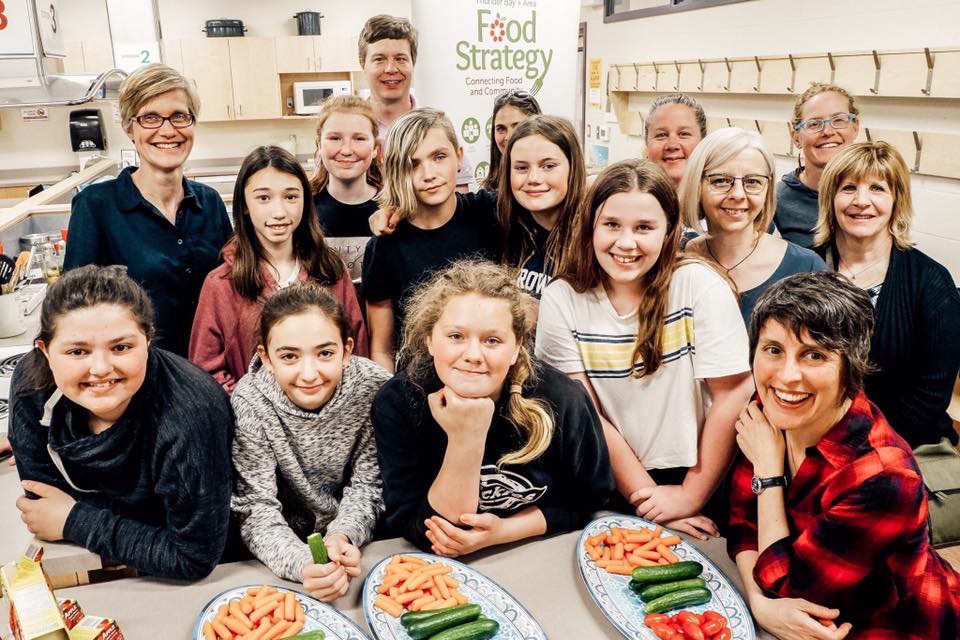Research in Action: Research Provides Direction for School Food Environments

Photo cutline: Celebrating the launch of the school food inventory report. Front row left to right: students Jordyn Jones, Brooklyn Hawkins, Danika Banning, Emma Sloss, and parent Jessica Carfagnini. Top row left to right: Karen Kerk (Food Strategy), students Kya Zechner and Phoebe Shaw, Dan Hobbs (Red Cross), students Jade Roberts Danni Gale, and Dawn Teepell, Barbara Parker (Lakehead University), Erin Beagle (Roots to Harvest), Gladys Berringer (Our Kids Count).
Published in the Chronicle Journal Tuesday, October 22, 2019.
By: PhebeAnn Wolframe-Smith
Children’s access to and knowledge about food has an enormous impact on their wellbeing. Healthy food environments are places where children have access to nutritious foods, are learning about food and food systems, and are able to use eating, cooking and/or growing food to help build community among students, teachers, staff, and parents.
Recognizing the importance of healthy food environments, the Thunder Bay and Area Food Strategy’s School Foods Environment Working Group set out to do a school foods inventory. The purpose of this project was to assess the current food environments of Thunder Bay and area schools, to understand where improvements could be made. The Working Group is comprised of representatives from community organizations engaged with food school programs, including the Thunder Bay Catholic District School Board and the Lakehead Public School Board.
Karen Kerk is a member of the Working Group and the Coordinator of the Thunder Bay and Area Food Strategy. “We learned a lot about how research works and about reaching out to the community. Once we started asking questions, it led to more questions we wanted to ask. It was a great process to see it come together from the initial idea to the surveys, to bringing the results back to the community and thinking about next steps,” she said.
Dr. Barbara Parker, Assistant Professor in Sociology at Lakehead University, is a member of the Working Group and led the research along with then-undergraduate student Mario Koeppel, who completed his honours thesis on the project.
Koeppel, from Switzerland, is a Master’s student in Sociology at Lakehead who is studying student food insecurity.
“Two important things I learned were the value of connecting with community – the Working Group was there for me to get perspectives on the work throughout the research process. The second thing was as a sociologist I got to put the methodologies I’ve learned into action, and to see how research could benefit the community,” Koeppel said.
Key findings of the inventory are that most schools don’t have a formal philosophy or policy around food, but have informal underlying principles, such as that no child should go hungry. There are Red Cross nutrition programs in all schools in Thunder Bay, but there are inequities among schools in terms of delivery: most rely on volunteers, and some schools have greater numbers of helpers than others. Some schools are able to provide a granola bar and a fruit, while other schools serve hot breakfasts and even lunches. Some schools have initiatives like community gardens, cooking programs, and Indigenous traditional food teachings, while others do not. Disparities in resources contribute to these differences. The results of the survey were launched in a report in May of 2019, which can be found at tbfoodstrategy.ca/resources/
Currently, the Working Group is helping school boards put the recommendations that came out of the inventory into action. Some of these recommendations are that schools develop food philosophies with their students, and that food programs be expanded. Dietician interns working with the Red Cross – a member of the School Foods Working Group – are developing tool kits to help teachers and principals create school food programs not just focused on nutrition, but also on the social and cultural context of eating.
“Around the world parents struggle to provide a healthy lunch their kids will eat or to provide a lunch at all. Food is about connection and relationships, but can also work to set individuals apart from one another and maintain difference. We want to use food and food policy to bring people together,” Parker said.


